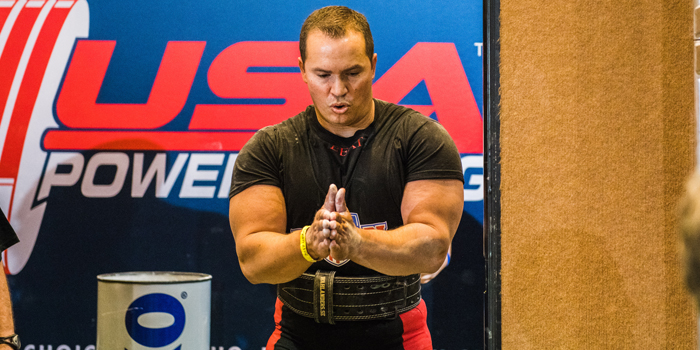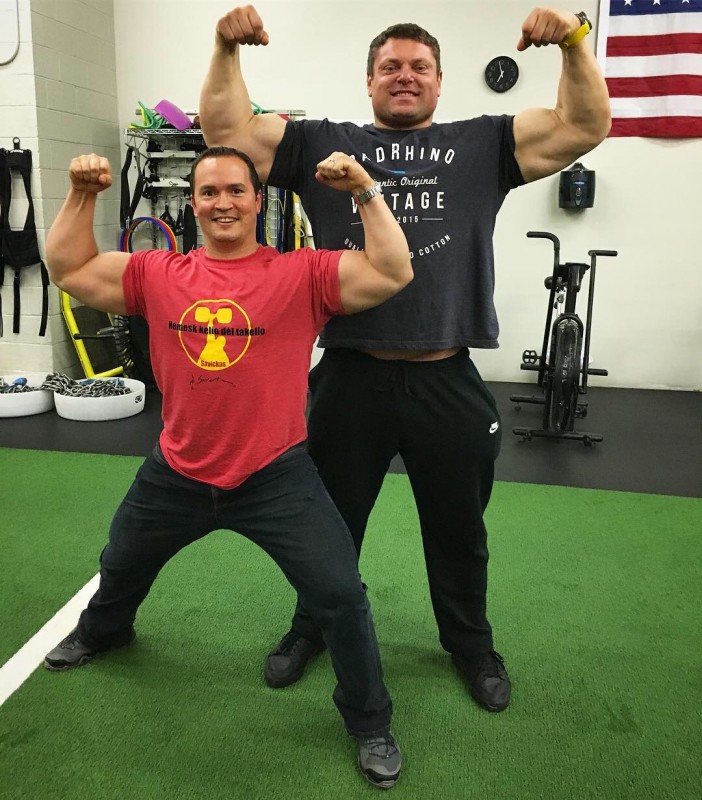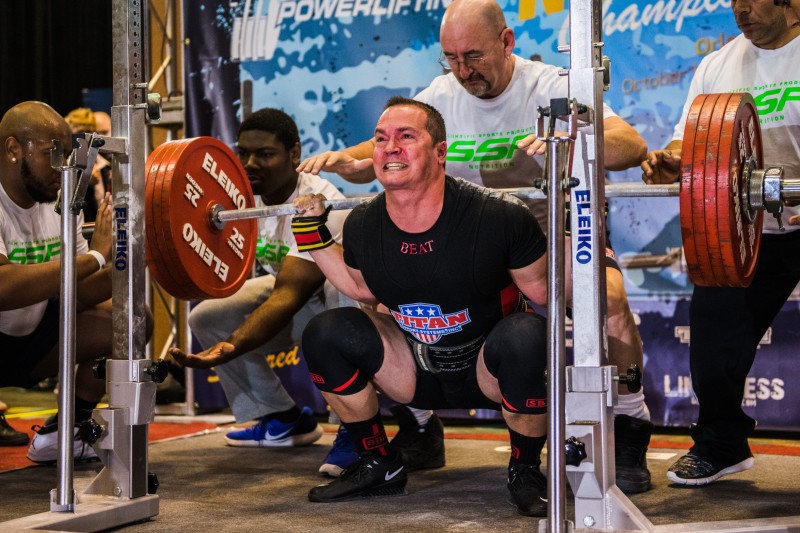
As a former 150-pound marathon runner–turned–powerlifter, I recognized that significant gains in the squat were likely to take time. To my surprise, progressing from a 315-pound squat to a 405-pound squat happened rather rapidly, but the jump from 405 pounds to 495 pounds – and the mythical 500 pounds – took much longer (I first squatted over 400 pounds in 2013; I did not squat over 500 pounds in a meet until 2017). Because of this, and because of how intimidating 600 pounds used to sound to me, I assumed that the next 100-pound increment would require many years (and initially, I probably questioned whether I’d get there at all). But instead of taking longer, my 500-pound to 600-pound transition actually took less time than the 400-pound to 500-pound journey did: I squatted 518 pounds at USAPL Raw Nationals in Orlando on October 13, 2017, and one year later – to the day – I squatted 600 pounds at Raw Nationals in Spokane. It was a milestone achievement that this 93kg Master (40+) lifter had dreamed of for some time.
But enough about me; let’s talk about you.
Here are the secrets to my accelerated squat gains that will help to unlock your untapped potential in this critical lift:
1. “Free your mind, and the rest will follow.”
Although it is true that believing you can do something will not necessarily mean you can actually do it, not believing you are capable of something will virtually guarantee that you will fall short. As I wrote in “34 Ways to Maximize Your Raw Bench”, mentally accepting the weight is critical to breaking new ground in terms of strength. Everyone knows the story of Roger Bannister breaking the supposedly impossible four-minute mile barrier in 1954 (followed by more than 1,400 other runners since); in my experience, this same phenomenon of rejecting arbitrary physical limits applies to new PRs in the gym. As marathon world record holder Eliud Kipchoge famously stated, “No human is limited.”
I noticed that as soon as I removed that arbitrary figure from my thinking (“I am capable of one day squatting X amount of pounds, but not more!”), my gains began to noticeably accelerate. This may sound corny or unrealistic to some, but there is plenty of science behind the power of the mental game. If you don’t believe me, read With Winning in Mind and How Champions Think. (Heck, read these books if you DO believe me – they are incredibly useful for strength athletes and other exceptional people.) Bottom line: stop holding yourself back by believing you are somehow never meant to surpass a certain number in the squat (or bench, or deadlift, or…).
2. Surround yourself with positive people.
In the same vein as not placing artificial limits on your potential, you need to recognize that the powerlifting (and other) company you keep can profoundly influence your technique, programming choices, self-confidence, and more. Find knowledgeable, dedicated lifters who strive to “keep it positive” when critiquing your efforts to grow stronger. Few, if any, people thrive in an environment where they are constantly getting torn down by those around them; most of us – no matter how strong our wills are – tend to be influenced to some extent by the negativity (or positivity) thrown our way. Your self-image, confidence, and belief in your potential are paramount to powerlifting and other success. Because of this, you cannot afford to allow any degree of degradation to settle in as a result of negative people who do not believe in you. Pick positive, powerful (meaning disciplined and committed, regardless of strength level) people as your lifting peers.

3. Find your true MRV.
Recently, I read an exceptional book on programming entitled Scientific Principles of Strength Training. In it, the authors highlight the importance of pinpointing your maximum recoverable volume, or MRV. In my case, my assumed MRV for the squat turned out to be well below what I could actually handle and recover from. I credit coach Dylan Smith of Big Three Strength with opening my eyes to a different, more voluminous way. By adding a third day of squatting to my intense (but low-volume) twice-per-week routine, I saw gains almost immediately. Meanwhile, it did not take my body long to adapt to the significantly increased workload, and this despite no longer being a spring chicken (I turned 40 this year). As award-winning USAPL coach Matt Gary likes to say, “If you want to squat more, squat more.”
4. Stop getting injured.
When I first began powerlifting, I brought to the sport a lot of passion and intensity (from my distance running, soccer, and bodybuilding days) but also a host of less-than-accurate training principles that I had acquired over the years. One of these erroneous notions was that of supposedly needing to go all out, all of the time to “force” the body to grow and become stronger. In fact, this type of training had the opposite effect, as I found myself getting injured in 2014, in 2015, and again in 2016 due at least in part to my failure to enable my muscles and connective tissue to properly rest and repair themselves. What I needed was a more intense focus on an exquisite, repeatable technique, on the one hand, and a new vision of optimal RPE on the other. The past two years have been the healthiest and most injury-free of my 7.5-year powerlifting journey, and – not surprisingly – they have produced the most rapid gains as well.
5. Embrace a more moderate RPE.
Speaking of RPE, or rate of perceived exertion, it was analyzing the training of world champion David Ricks that opened my eyes to a new way of pushing myself. For the uninitiated, Mr. Ricks is 59 years old, yet he held the open (meaning all ages) 93kg IPF world record squat of 716 pounds until it was beaten in Calgary this summer. That, to me, is incredible. I studied his training protocol and found that he pushes his RPE beyond 8 and 9 (meaning, he leaves just one or two reps left in the tank) only rarely; the vast majority of his training is more volume focused at lower intensities (in other words, lower percentages of his 1RM). If David could stay healthy and keep progressing through his 40s and 50s in such a program, then perhaps so could I, I surmised.
It was by switching to a protocol that had me training the bulk of the time at RPE 6-8 (instead of 8.5, 9, and 9.5) that significantly boosted my gains in the squat. By taking the RPE down a notch or two, I was able to greatly increase my volume and see a reduction in the wear and tear that had crept up on me in the past and led to a host of injuries.
6. Take responsibility for your nutrition and recovery.
Many of us strength athletes are passionate about training but less enthusiastic about eating and sleeping well. Problem is, recovery and rebuilding happens when we are not training, making those “less sexy” aspects of muscle and strength gain absolutely critical. I’ll be the first to admit that I am not Mr. Chef – I do not enjoy cooking – but there are still ways to ensure that I am optimizing my macronutrient profile and total food intake. For me, this entails incorporating easy-to-pack options for work and travel.
Here are some of my go-to foods to help me to ensure that I consume enough protein and calories to keep gaining strength: an ready-to-drink(RTD) protein drink first thing in the morning; two packets of protein oatmeal as part of an early breakfast; multiple yogurts mid-morning; and a variety of meats and nuts as part of lunch. In addition, I doubled my post-workout serving over the past year and began to incorporate a casein shake into my pre-bedtime routine. In terms of sleep, I have begun to take short (20- to 30-minute) naps after my Saturday morning training sessions, which many times are squat-bench-deadlift (SBD) efforts that can be quite taxing. Although 20-30 minutes may not sound like much, I have noticed a more rapid return to homeostasis (feeling normal again) thanks to this recovery initiative.

Image courtesy of 9for9 Media
7. Find a programming strategy that works for you, and patiently ride that wave.
I will bet that many readers know someone in their gyms who jumps from program to program as he or she learns that the latest big name has found success with this or that strategy. Heck, maybe you are doing this now! Truth is, powerlifting is a sport not to be measured in terms of weeks and months, but rather in terms of years and even decades (Mike Sichelman, USAPL Chairman for Maryland, told me this when I started the sport). When you find training strategies that work, you should stick with them until they no longer work. For me, that “money” strategy over the last year has been tempo squats.
Coach Dylan Smith incorporated tempo squats into my squat programming after Raw Nationals in 2017. Since that time, I have dedicated a full month of every three-month cycle to this squat variation, and the results have been nothing short of remarkable. I strive for a four-second descent while maintaining “perfect” form throughout the movement. I treat every rep as a single, resetting in between reps in order to make them repeatable and competition-esque. This massive focus on time under tension resulted in my squatting 515 for six reps at RPE 8.5 last month – less than 11 months after squatting 518 for the first time in my life. There is something special about the eccentric (muscle lengthening) phase of the squat, and although sets of seven reps will make you dig very deep at times (they can seem to last forever!), the results are more than worth the effort. Again, find what works, and stick to it. There will be a time for trying out new things when you have milked this cow dry.
8. Lose the ego, and learn from others.
I will be the first to admit that I love doing my own programming and taking full responsibility for my gains. That said, there comes a point in every lifter’s life when he or she should consider handing off the reins – even temporarily – to someone qualified who does powerlifting programming and coaching for a living. For me, that time came after six years of training, and the coach was Dylan Smith. Dylan treated me like an equal and helped me to understand that given my level of experience and background (a certified USAPL coach with many years of competing under my belt), he was open to my take on the programming he had written up for me. In spite of this, I elected to embrace his plan without pushback or tweaks, as I wanted to see where it might lead. This proved to be an excellent move, as my squat literally skyrocketed after I adopted his plan (which included a three-times-per-week squat protocol and extended periods of tempo and pause squats – movements that were new to my routine). If your gains have stalled and you have been on the fence about engaging the assistance of a coach, I highly suggest that you give it a try for at least 90 days to see what happens to your gains.
9. Peak properly for your 1RM.
It is a fact that no matter how strong you are in training, if you fail to peak properly, you risk leaving pounds (sometimes a significant amount of them) on the platform. Although everyone is different in this regard, we all need to ensure that we decrease fatigue as much as possible while maintaining our strength; only then will we be in a position to express our maximum amount on meet day. In my case, this entailed cutting back much more than I had in the past, meaning I did my last heavy deadlift 2-2.5 weeks out, my last heavy squat 1.5-2 weeks out, and my last heavy bench 1.5-1 week out. I have used this protocol for the past two meets, and it has worked wonders for me (I finally hit my first nine-for-nine attempts in a meet this July). Do not misunderstand me – I am not claiming that this protocol will be the right one for YOU, but I am stating that you need to experiment with different options in the offseason to learn what your body responds best to when it matters. Do not leave peaking to chance!
10. Execute on game day by making your nerves work for you.
Now that I understand this concept better and have implemented it successfully on game day several times, it is one of my favorite principles. Dr. Bob Rotella (How Champions Think, p. 141) puts it this way (he focuses on golf, so I have altered the wording to reflect powerlifting):
“The [lifter] clears his mind and forgets about his last [attempt] and all previous and future [attempts]. There is only the [attempt to be executed]. There is only the present moment. He doesn’t think about the consequences of the [attempt] or about the way it will affect the results of the [meet]. […] he trusts that his body can execute the [attempt]. He turns off the conscious brain. He lets the subconscious—where the best control of fine motor skills can be found—govern his movements.”
Speaking from experience, I can state that what Dr. Rotella recommends is both possible and optimal for executing on game day. The training is done when the meet begins; all that is left is to trust that it worked, that you are strong enough to hit the attempts you have carefully selected, and that your body instinctively knows what to do when you have that crisp knurling married to your chalked-up palms in front of the crowd. It is normal to have some nerves, but they can work for you if you combine them with a subtle confidence that “you’ve got this,” “this is what you do,” and “this is who you are.” This is not the time to think – it is the time to gently, confidently smile because you know you will get the lift. And then you execute flawlessly, instinctively!
Although I cannot guarantee that the pace of your gains will match mine from the past year, I am confident that incorporating these tips will result in significant, sustained progress in the squat. And, for some of you, I have no doubt that you’ll see even MORE progress than I did. More power to you! As they say, “trust the process,” and work both hard and smart for an opportunity to finally hit that landmark PR. Speaking from experience, that moment is well worth the wait.
Keep grinding, my friends. I’m rooting for you.
References
- Bassham, Lanny. With Winning in Mind. 3rd ed., Mental Management Systems, 2011.
- Israetel, Mike and James Hoffman and Chad Wesley Smith. Scientific Principles of Strength Training. Renaissance Periodization, 2018.
- Rotella, Bob and Bob Cullen. How Champions Think. Simon & Schuster, 2015.
Nathaniel Hancock is a national powerlifting competitor in the USAPL federation. He is a former Maryland state record holder in the bench press, the 2016 USAPL 105kg Push-Pull National Champion, and the 2018 USAPL Raw Nationals runner-up in the M1 (40-49) 93kg category. His max lifts include a 600-pound squat and a 445-pound bench. A former marathoner and state champion bodybuilder in Utah, Nathaniel transitioned to powerlifting training in 2011. He is a certified personal trainer and has been featured in international fitness magazines. He and his wife have four children and reside in Maryland.
Header image courtesy of 9for9 Media











He also looks like Ragnar Lothbrok which adds an immediate 20kg to all lifts.